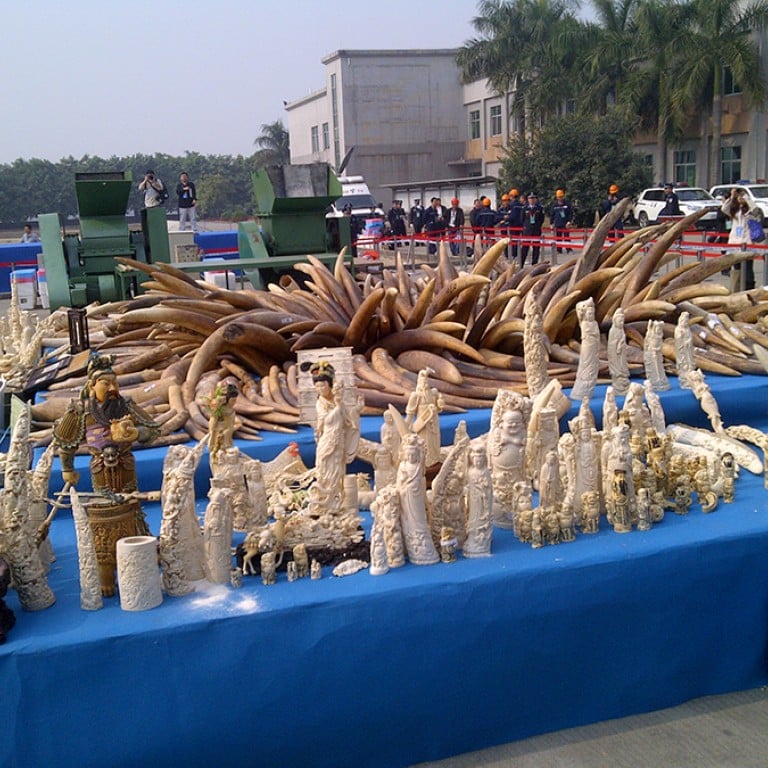
China destroys 6.1 tonnes of confiscated ivory in gesture reflecting major policy shift
China destroyed over six tonnes of confiscated ivory for the first time in Guangdong’s Dongguan, marking a significant effort to combat illegal wild elephant tusk trading by the world’s largest ivory consumer.
China destroyed over six tonnes of confiscated ivory for the first time in Guangdong’s Dongguan, marking a significant effort to combat illegal wild elephant tusk trading by the world’s largest ivory consumer.
The destruction of confiscated ivory by Chinese authorities is the first landmark gesture reflecting a policy shift by Beijing in the handling of confiscated ivory which used to be kept in storage without further action.
The destruction ceremony kicked off in the afternoon in Dongguan’s Machong township where 6.1 tonnes of ivory sculptures and raw tusks over three feet long each were crushed into pieces by two giant machines, witnessed by diplomats, international guests, conservationists and media. Ivory is worth between US$1,000 and US$2,000 per kilogram in the black market, according to John Scanlon, secretary general of the Convention on International Trade in Endangered Species of Wild Fauna and Flora (CITES).
The destruction comes a month after China pledged during the African Elephant Summit in Botswana of Africa on December 2 last year to take action in combating ivory trading, according to Zhang Li, associate professor at Beijing Normal University and elephant expert.
"It’s a really big and quick decision just in one month," Zhang said.
"After Gabon, Kenya, the Philippines and the United States, China is the next government to take real action to destroy illegal ivory stockpiling. This shows strong willing from China to protect the wild elephant population as well as wildlife trade," he added.
"This is significant progress because there is an elephant crisis caused by record-high poaching in the past two to three years," Zhang said.

According to Monitoring the Illegal Killing of Elephants (MIKE), a body set up as part of an international regulation over the legal sale of ivory from approved countries, about 7.5 per cent of wild African elephants were slaughtered in 2012, along with a further 7.9 per cent in 2011 wild, surpassing the average growth rate of 5 per cent.
"This means in the past years, wild African elephants’ populations declined by 2 per cent every year. In about 50 years, they will disappear without major protection efforts. It’s a serious problem caused by poaching and illegal killing," Zhang said.
In 2013, there were around 470,000 wild African elephants compared to 1979 when the population stood over 1.3 million, according to Zhang.
China has confiscated at least 16 tonnes of ivory in the past three years, according to media reports. Zhang said the remaining stockpiles have not destroyed because they are subject to ongoing court proceedings. However, the total volume of ivory stockpiling in China remains unknown.
Andrea Crosta, executive director and co-founder of Elephant Action League, said the destruction was an important symbolic gesture from China in acknowledging that illegal ivory, being the product of illicit and criminal activities, sometimes even linked to terrorist groups, must be destroyed.
"It’s a moral obligation to destroy the seized ivory, all over the world, not just in China," said Crosta, who added that many people die every year trying to protect or kill an elephant, with orphans and widows left behind and terrorist groups getting funds from poaching wild elephants.
However, Crosta said he feared today’s public destruction could be nothing more than a public relations exercise designed to ease international pressure by showing the world China is taking action – even though it did not destroy all of its confiscated ivory.
“Tens of tonnes of illegal ivory keep entering China every year and are laundered into the legal market. This is the single most important factor behind the current elephant poaching crisis,” Crosta said.
The ivory seized in the city since 2010 is equivalent to the tusks of just 3,300 elephants, yet 25,000 African elephants were slaughtered for their ivory in 2012 alone. Crosta says a lot more is being successfully smuggled. The price in 2010 is about US$700 per kg. More than six tonnes of elephant ivory worth close to HK$50 million was confiscated in Hong Kong from October 2012 to January 2013.
A ban on the global trade of ivory has been in place since 1989. There have been two one-off, sanctioned sales since, in 1999 and then in 2007, when 106 tonnes of ivory stockpiles were sold mainly to China and Japan.
Watch: CCTV News report on China's elephant tusk destruction
There has been a sharp rise in poaching since the last sanctioned sale in 2007, data from the Convention of International Trade of Endangered Species (CITES) shows.
At the same time, the wholesale price of ivory has tripled since 2006, alongside increased demand for the precious item at auction houses, according to a 2011 report by Gabriel’s organisation on ivory markets in China.

